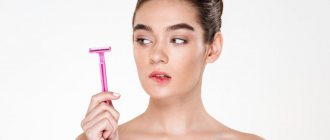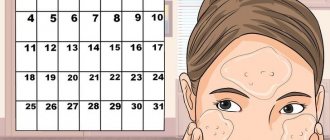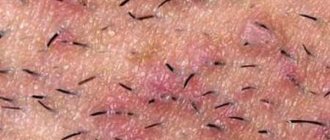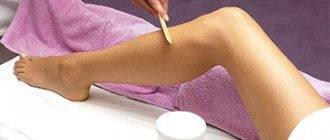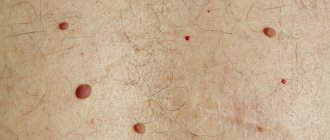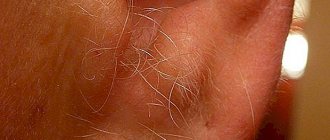Facial hair in women: why it grows and what to do
Facial hair can grow either constantly or sporadically. Most often these are light, short and brittle hairs that resemble fluff. They are so invisible that sometimes women are not even aware of their existence. But sometimes the hair is black, hard and thick, resembling stubble - they are called terminal (another name is rod).
If a woman suddenly begins to grow hair on her chin, cheeks, upper lip, back, buttocks, stomach and chest, it may be hirsutism. This disease occurs due to increased production of androgens - steroidal male sex hormones.
Main reasons
Why do women grow such facial hair? This is not easy to figure out because there are many possible causes. Below is a list of the main ones.
- Hormones. Hair on the chin and above the lips in women can grow at a time when the body is under great stress. For example, the first menstruation has begun or, conversely, menopause is approaching. Then female hormones malfunction, and male hormones, on the contrary, become more active, and there are even more of them. Most often, such an imbalance is temporary.
- Contraceptives. Oral contraceptives contain hormones, so taking them without a doctor's prescription is not recommended. But often women buy birth control pills on their own, after watching an advertisement or asking a friend for advice. Incorrectly selected OCs can lead to big problems.
- Heredity. If your closest relatives (mother, grandmother, sister) suffer from increased hairiness, there is a high probability that you will not be spared this disease. If your family has ancestors from the Caucasus or the Mediterranean, there is also a risk of growing a beard.
- Ovaries. Gynecological problems are often associated with hormonal imbalance. And with polycystic ovary syndrome, there is even a separate symptom: “a mustache and beard begin to grow.” This occurs due to a complete disorder of the reproductive system. In general, any disturbances in the functioning of the ovaries can lead to increased hair growth.
- Thyroid or adrenal glands. They are the ones responsible for the entire functioning of the endocrine system, but if problems or malfunctions arise in their work, wait for the mustache.
- Tumor. If a tumor of the pituitary gland occurs, the functioning of the adrenal glands is disrupted. Then they produce a lot of testosterone and, as a result, there is an increase in the amount of unwanted hair on the body.
- Pregnancy. During pregnancy, hormonal imbalances also occur. Fuzz or white hair appears on the cheeks of women. This phenomenon also occurs after childbirth.
- Ecology. Residents of environmentally unfavorable areas are often diagnosed with disturbances in the functioning of internal organs and systems. Hormonal functions are also at risk.
- Stress. Don't be surprised, but any situation that throws you out of your usual rut can lead to beard growth.
- Obesity. If you lead a sedentary lifestyle and eat just anything, your internal organs will work hard and natural metabolic processes will be disrupted. So, in addition to sagging sides, with an incorrect diet, a girl runs the risk of getting the problem of unwanted hair.
- Inappropriate cosmetics. Imagine, if you use cosmetics that do not suit you in composition, you can ruin your appearance. For example, a girl is only 18 years old, but she bought herself a cream for 35-year-olds. In this case, instead of velvet skin, there is a high probability of growing a remarkable mustache.
- Radical removal. You should not get rid of vellus hair using radical methods, such as a razor or epilator. Firstly, such hair is completely invisible to others and does not spoil a woman. Secondly, after removing any of them, hard stubble will begin to grow.
- Medicines. Long-term use of a number of medications (almost all hormonal drugs, some antibiotics and immunosuppressive drugs) can serve as an impetus for the active appearance of facial hair.
If you find that hair has begun to grow on your face, be sure to visit a therapist, gynecologist and endocrinologist. You will be told which hormones to check, which tests to take, and which tests to take. As a rule, in addition to general blood and urine tests, it is necessary to conduct a hormonal study of the thyroid gland - TSH, T4, T3. It is also important to determine the level of testosterone, cortisol, prolactin and dehydroepiandrosterone sulfate. It is possible that a series of ultrasounds will be needed.
What, how and with what to treat
What to do if a woman has hair growing on her face? Wait for the research results. Once the cause is determined and the doctor prescribes treatment, strictly follow the recommendations.
There are several degrees of hirsutism. If mild is diagnosed, then no special treatment is required. If doctors suspect something more serious, it will be necessary to undergo drug therapy or undergo surgery, for example, to remove a tumor.
Treatment of hirsutism with medications is long-term, since it is necessary to accumulate the necessary “base”, ready to deal with the main problem. Hormones are most often prescribed. The cycle is designed for a minimum of three months, but occurs intermittently and lasts at least six months. Often the course has to be repeated, and more than once.
Doctors advise: there is no point in thinking about how to remove facial hair until the cause of its appearance has been eliminated. After all, cosmetically masking a deficiency will not actually solve anything. What is the treatment?
- Testosterone-lowering drugs. They reduce the body's sensitivity to androgens. In particular, some oral contraceptives have such properties.
- Drugs for the adrenal glands. Therapy is also carried out with hormonal medications.
- Chemotherapy. This is a last resort method, which is used in particularly advanced cases, and if the cause of hirsutism is a tumor.
Hormonal treatment should be abandoned if a woman:
- pregnant;
- breastfeeds the baby;
- does not tolerate medications (individual reaction);
- has malignant formations.
In addition to medications, the treatment of hirsutism requires a diet (it is recommended by the doctor depending on the patient’s health and body weight) and even often the help of a qualified psychologist.
Video on the topic Albina talks about removing female mustaches
A few words about androgens
There are several types of androgens, the most famous of which is testosterone. In the male body, this hormone is involved in the formation of sperm and the development of male characteristics (a rough voice, body hair growth, etc.).
Testosterone is normally present in the female body, but in small quantities, and affects the menstrual cycle, libido and fertility (the ability to reproduce). Accordingly, an increase in the level of this hormone in women leads to male-type functional changes.
Other male sex hormones are androstenedione and dehydroepiandrosterone, which are subsequently converted into testosterone (see testosterone levels in women and men).
Classification of changes - from fluff to stubble
When the balance of hormones responsible for hair growth in women is disturbed, a change from fluff to stubble occurs, that is, the fluff becomes terminal. The latter have higher rigidity, they are dark and long. Types of changes:
- adrenal – the level of adrenal hormones (cortisol), male steroids (testosterone, androstenedione, dehydroepiandrosterone) increases;
- ovarian – occurs with ovarian diseases, ovulation disorders (the release of an egg from the follicle);
- pituitary – when the pituitary gland of the brain is damaged, the effect of pituitary hormones is manifested by increased function of the adrenal glands;
- medicinal – associated with the use of hormonal drugs.
Depending on the accompanying disorders, several clinical forms are distinguished:
- only increased growth of facial hair, without other changes;
- facial hair and acne, seborrhea (increased oily skin);
- skin signs and menstrual irregularities, infertility;
- hair growth on the legs, along the linea alba, around the nipple, hair loss on the head.
Symptoms of hirsutism
- Male pattern hair growth in women: growth of hard, pigmented shaft hair on the face (upper lip, chin), around the nipples, on the chest, back, abdomen, buttocks and inner thighs;
- Increased oiliness of hair and skin;
- Acceleration of hair loss on the head, especially in the forehead area;
- Acne is an inflammatory change in the pilosebaceous structures of the skin;
- Menstrual dysfunction in the form of irregular periods or their complete absence;
- Infertility, inability to conceive a child for a long time.
With hirsutism against the background of hyperandrogenism, signs of virilization or masculine features subsequently appear:
- increased libido;
- increase in muscle mass, especially in the upper shoulder girdle;
- redistribution of fat according to the male type (localized on the shoulders, arms, chest);
- reduction of glandular tissue of the mammary glands;
- deepening of the voice;
- hair loss in the temple area;
- attraction of the clitoris, reduction in the size of the labia, cessation of the production of vaginal lubrication.
Traditional treatment
It should be understood that without traditional treatment, the symptoms of the disease will continue to appear. Traditional medicine makes sense in the idiopathic form of the pathology and as a method of hair removal after the main hormonal treatment.
- Juice of unripe walnut. The green nut is cut into 2 parts and the juice is squeezed out, which will be quite a bit. Apply droplets of juice to the hair roots. After 3-4 applications, hair growth will slow down.
- Fresh garlic. Fresh garlic paste is applied to the hair roots for 10 minutes. Regular use of such a mask also leads to slower hair growth.
- Datura decoction. The crushed leaves and stems of the plant are poured with water (so that it covers them) and slowly simmered over low heat for 60 minutes. The resulting decoction is applied to the hair roots 2 times a week very carefully, since the plant is poisonous.
Traditional hair removal remedies that don't work
Popular folk techniques help to get rid of unwanted hair forever at home, although not all remedies are effective. Many methods do not remove coarse hair, others only help to lighten or remove hair for a short period.
Uses of iodine
In some sources you can find information about hair removal with iodine. In fact, application of the drug can cause a widespread allergic reaction and leave dark spots on the skin that cannot be quickly washed off with conventional means.
Application of soda
This is an ineffective way to remove vellus antennae, but it is often recommended for use at home. It is generally accepted that soda can corrode the hair follicle and slow down the formation of the follicle.
Soda mask
In fact, prolonged exposure to a soda solution can lead to noticeable damage to the upper layer of the dermis. The reaction will appear as severe redness followed by peeling of the skin. And the fluff will not stop growing.
As a result, the area that was treated with soda solution will be dry and painful to the touch. The only thing that can be achieved with the help of repeated soda lotions is lightening the vellus part of the follicle.
